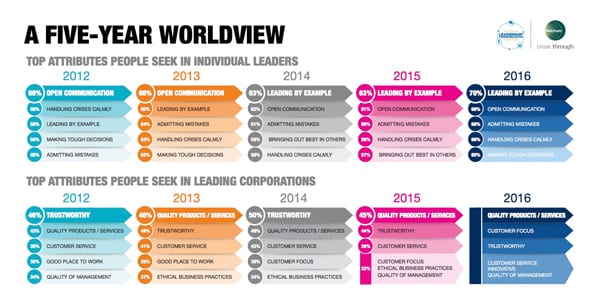 Five years ago, we set out–through our annual Ketchum Leadership Communication Monitor (KLCM) Study–to answer two simple questions: “What does the world think of its leaders?” and “What can those leaders, and the organizations they steer, do to restore confidence? (click to tweet)” Issues that lie at the heart of what we do to help organizations, and those at their helm, establish and maintain leadership advantage.
Five years ago, we set out–through our annual Ketchum Leadership Communication Monitor (KLCM) Study–to answer two simple questions: “What does the world think of its leaders?” and “What can those leaders, and the organizations they steer, do to restore confidence? (click to tweet)” Issues that lie at the heart of what we do to help organizations, and those at their helm, establish and maintain leadership advantage.
Fast-forward to today as we unveil the fifth edition of KLCM–less than a week after last Thursday’s UK’s Brexit vote sent shock waves around the world’s financial markets and corridors of power. We could not have imagined that our exploration of this critical area could be quite so relevant.
As political leaders across Europe strive to convey a sense of stability, and British politics comes to terms with a short-term leadership vacuum, conversations with more than 25,000 members of the public over those five years have revealed a detailed picture of people’s views of leaders around the world–across five continents and 22 industries. Revealing a low-trust, high-expectation gap as the new normal for leaders, with deep-seated leadership concerns having a direct, sizeable impact on bottom-line outcomes and political systems.
Looking at this year’s findings, while also standing back and surveying the five-year vista, a single, striking theme shines through–the critical importance of breaking through persistent barriers to great leadership.
- In 2013, we found an inbuilt tendency of people to believe that leaders aged 35 to 49 and at the height of their powers are the most effective source of leadership.
- In 2014, our exploration of gender and leadership revealed that while the world still looks most to male leaders, people are markedly more impressed with female leaders than their male counterparts. Suggesting that the future of leadership communication will be more “feminine” – with practical lessons for leaders of both genders
- Last year in 2015, we highlighted the rise of the title-less leader, with respondents favoring by far leadership provided by the entire organization and everyone within it, rather than just from the CEO or senior management
- This year, our exploration of leadership issues such as religion, ethnicity, disability and sexual orientation has revealed a leadership glass ceiling stretches way beyond gender. Shockingly, for all of the social progress of recent decades, a majority of respondents globally view four of those five issues as standing in the way of equality of leadership opportunity – with almost half feeling the same for religion.
Crucially, with political leaders, laws and legislation seen as much a part of the problem as the solution, there is an unprecedented opportunity for the corporate sector to lead the way in shattering the leadership glass ceiling. With huge reputational and commercial dividends for those willing to do so in their words and actions in an environment that has seen the right of traditional politicians to lead fundamentally questioned across the globe.
 For business leaders to enjoy the full benefits of grasping this particular bull by the horns, the key will be starting with a simple, honest question, “How ready are we? Here are our best practices summed up into five areas:
For business leaders to enjoy the full benefits of grasping this particular bull by the horns, the key will be starting with a simple, honest question, “How ready are we? Here are our best practices summed up into five areas:
1. What measures do you have in place to ensure reasonable expectation-setting and to avoid “say-do” gaps between what you do and the expectations you set through what you say (especially in a crisis)?
2. How open are those in your organization – individually and collectively – to genuinely listening to understand your audiences’ definition of transparency?
3. Does your approach to leadership balance a clear vision with a willingness to admit mistakes and make continuous improvements?
4. How committed are you and your organization to enabling leadership at every level?
5. Beyond legal and legislative requirements, how are your leaders breaking down barriers to equal leadership opportunity in areas such as gender, age, ethnicity, religion, sexual orientation, class and disability?
Let’s be clear–there is a big job to do here and the events of the past week have highlighted that fact in dramatic fashion. At no point in five years have more than 25 percent of respondents said leaders are leading well, with under one in five expecting an improvement in leadership next year. So as we continue to work with our clients in navigating a course to more effective leadership communication, we hope others will join a conversation that has never felt more relevant and critical to our collective future.


